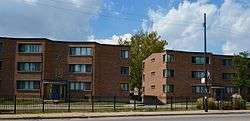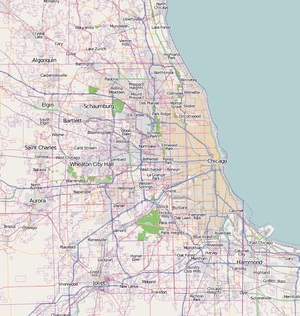Parkway Garden Homes
Parkway Garden Homes is a low-income apartment complex located in the Greater Grand Crossing neighborhood on the South Side of Chicago, Illinois. The complex was built from 1950 to 1955; architect Henry K. Holsman, who planned several of Chicago's affordable housing developments, designed the Modernist buildings. The apartment complex was the first to be cooperatively owned by Chicago's African-American residents, who experienced a housing shortage during the Second Great Migration due to segregation; early residents included former First Lady Michelle Obama. In recent years, however, the complex has become the center of one of Chicago's most violent blocks. The complex is listed on the National Register of Historic Places.
Parkway Garden Homes | |
 | |
 | |
| Location | 6330-6546 S. Dr. Martin Luther King Jr Drive, Chicago, Illinois |
|---|---|
| Coordinates | 41°46′36″N 87°36′59″W |
| Area | less than one acre |
| Built | 1950-1955 |
| Architect | Henry K. Holsman |
| Architectural style | Modern |
| NRHP reference No. | 11000848[1] |
| Added to NRHP | November 22, 2011 |
History
Parkway Garden Homes, built from 1950 to 1955, was the last of Henry K. Holsman's many housing development designs in Chicago. Holsman began designing low-income housing in Chicago in the 1910s, when an urban housing shortage developed after World War I. He worked on several of the Chicago Housing Authority's major housing projects in the 1930s; later in the decade, he began developing his own projects with funding from the Federal Housing Authority. From the 1940s onward, Holsman focused on designing residences for Chicago's African-American citizens, such as his Princeton Park community. While Chicago's African-American population boomed from 1920 to 1970 due to the Great Migrations, discriminatory housing policies forced African-Americans to live in the "Black Belt" section of the city's South Side, which did not have enough housing to meet demands. After completing the Winchester-Hood and Lunt-Lake Apartments on the North Side, Holsman began work on the similarly-designed Parkway Garden Homes as a return to the South Side African-American community. The complex replaced the White City Amusement Park, which had operated at the site since 1905. Holsman's firm went bankrupt before the complex opened due to unsound financial decisions, one of which resulted in Holsman's conviction for mail fraud.[2]
The complex was the first cooperatively owned African-American housing development in the United States. While Holsman had worked on cooperative housing in the past, its adoption by African-Americans was considered a major success for the community. Mary McLeod Bethune gave an address at the development's cornerstone-laying ceremony, which was attended by Governor Adlai Stevenson II, Chicago Mayor Martin H. Kennelly, and both of the state's U.S. Senators. Advocates for affordable housing and civil rights praised the development when it was completed, citing its modern heating and appliances and its expansive units. The complex attracted African-American residents from lower-income backgrounds, including future First Lady Michelle Obama's family, who lived there at the time of her birth.[2]
As gang activity increased in the neighborhood in the 21st century, Parkway Garden Homes became the center of one of Chicago's most violent blocks. The 6400 block of South King Drive, known locally as O Block after murder victim Odee Perry, had the most shootings of any block in Chicago between June 2011 and June 2014. Many of these shootings occurred in 2011-12, and city police report that violence at the complex has steadily declined since. The violence mainly stems from gang rivalries between the Gangster Disciples and Black Disciples, who both control territory near the block.[3] Rapper Chief Keef, whose music often references O Block and its violence, spent time in the Parkway Garden Homes before becoming successful.[4]
The complex was added to the National Register of Historic Places on November 22, 2011, for its architectural significance and its role in African-American community development.[1][2]
Architecture
Holsman gave the Parkway Garden Homes a Modernist design inspired by European housing projects of the 1920s and 1930s. The complex is low-rise and includes several walk-up buildings, giving it a personal feel at a time when skyscraper housing projects were common. Thirty-five buildings are included in the complex; twenty-four of these are walk-up buildings, while the remaining eleven are eight-story buildings. The development's layout emphasized spaciousness, light, and airflow and pointed entrances toward the inside of the complex rather than the street. In lieu of ornamentation, angled bays gave variety to the exteriors, a feature inspired by German "zig zag houses". The few decorative elements, which include cantilevered balconies and ribbon windows, are typical of Modernist buildings.[2]
References
- "Weekly List of Actions Taken on Properties: 11/21/11 Through 11/25/11". National Park Service. Retrieved November 3, 2014.
- Ramsey, Emily (February 15, 2011). "National Register of Historic Places Registration Form: Parkway Garden Homes" (PDF). National Park Service. Retrieved November 3, 2014.
- John Eligon (December 22, 2016). "Bored, Broke and Armed: Clues to Chicago's Gang Violence". The New York Times. Retrieved December 23, 2016.
- Main, Frank (October 31, 2014). "The most dangerous block in Chicago". Chicago Sun-Times. Archived from the original on November 2, 2014. Retrieved November 3, 2014.(dead link)